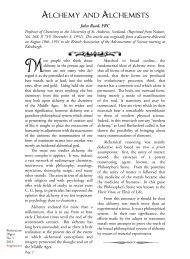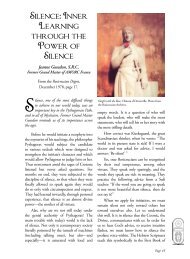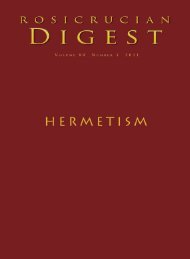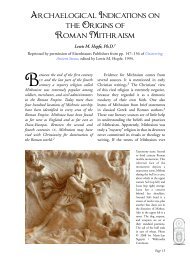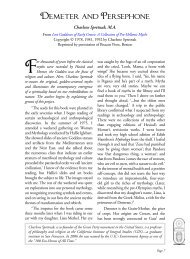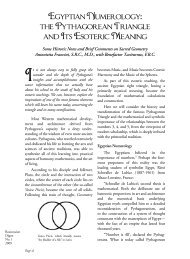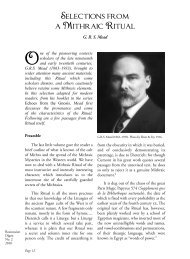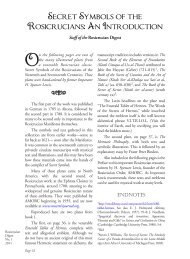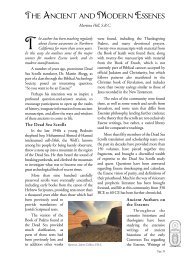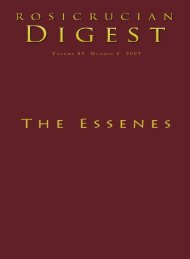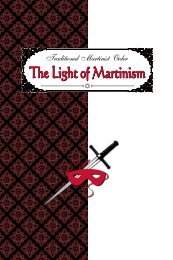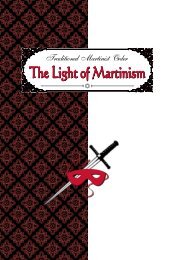Pythagorean Teachings across the Centuries - Rosicrucian Order
Pythagorean Teachings across the Centuries - Rosicrucian Order
Pythagorean Teachings across the Centuries - Rosicrucian Order
You also want an ePaper? Increase the reach of your titles
YUMPU automatically turns print PDFs into web optimized ePapers that Google loves.
alive <strong>the</strong> voice of <strong>the</strong> Master. In addition,<br />
it was possible to listen to <strong>the</strong> many stories<br />
in which <strong>the</strong> pain of <strong>the</strong> destruction of<br />
<strong>the</strong> school was still fresh. Also in such<br />
surroundings, memories were preserved<br />
with great care in certain families and could<br />
suggest to <strong>the</strong> sensitive mind of Plato <strong>the</strong><br />
correct materials for a reconstruction of a<br />
true and most genuine <strong>Pythagorean</strong>ism.<br />
According to Gomperz, Plato made<br />
use of this information to construct a link<br />
between <strong>the</strong> Socratic and <strong>the</strong> <strong>Pythagorean</strong><br />
teachings. Never<strong>the</strong>less, Plato, following <strong>the</strong><br />
tradition of silence, at <strong>the</strong> beginning rarely<br />
mentions <strong>the</strong> <strong>Pythagorean</strong>s. After his first<br />
trip to Italy, unavoidably and progressively<br />
he is more and more attracted to <strong>the</strong> voice<br />
of <strong>the</strong> “<strong>Pythagorean</strong> Siren,” so much so that,<br />
beginning with Meno, in his later dialogues<br />
and in <strong>the</strong> teachings of his immediate<br />
successors, we can witness <strong>the</strong> “inclusion of<br />
Platonism into <strong>the</strong> greater <strong>Pythagorean</strong>ism.”<br />
This change is also notable in Phaedo.<br />
In this work, Plato introduces Cebes and<br />
Simmias, <strong>Pythagorean</strong>s from Thebes, as<br />
those who listen to <strong>the</strong> last words of <strong>the</strong><br />
dying Socrates, and talk with him about<br />
immortality. This choice is relevant, as Plato<br />
did not place some Sophists or followers of<br />
Heraclitus or Anaxagoras at <strong>the</strong> scene; ra<strong>the</strong>r<br />
he chooses <strong>Pythagorean</strong>s. 4<br />
<strong>Pythagorean</strong> Elements in Aristotle’s Work<br />
Aristotle himself felt <strong>the</strong> influence of<br />
<strong>the</strong> <strong>Pythagorean</strong> doctrine, not only because<br />
he attended <strong>the</strong> Academy for twenty years,<br />
but also because he took part in <strong>the</strong> interesting<br />
meetings of <strong>Pythagorean</strong> savants. His<br />
early work, On Philosophy, discusses <strong>the</strong><br />
teachings of <strong>the</strong> <strong>Pythagorean</strong>s and Plato; and<br />
similarly, he does so in Eudemus (or “On <strong>the</strong><br />
Soul”), and Protrepticus, of which we only<br />
have short passages.<br />
According to Vincenzo Capparelli,<br />
Aristotle was one of <strong>the</strong> greatest students of<br />
Bust of Aristotle. Marble, Roman copy after a Greek bronze<br />
original by Lysippos from 330 BCE. The alabaster mantle<br />
is a modern addition. Palazzo Altaemps, Roma. Photo<br />
©2006 by Marie-Lan Nguyen/Wikimedia Commons.<br />
<strong>Pythagorean</strong> doctrine, “Not only because<br />
of <strong>the</strong> many years spent at <strong>the</strong> Academy,<br />
where he had <strong>the</strong> opportunity of learning<br />
all that was known <strong>the</strong>re. This information<br />
was <strong>the</strong> result of <strong>the</strong> long researches made by<br />
Plato himself, and because of <strong>the</strong> systematic<br />
historic research that he himself did (or was<br />
done by his students), Aristotle was able to<br />
have a rich and vast library.”<br />
In his Metaphysics, Aristotle wrote,<br />
“With respect to <strong>the</strong> activity of <strong>the</strong>se<br />
philosophers called <strong>Pythagorean</strong>, <strong>the</strong>y<br />
began <strong>the</strong> study of ma<strong>the</strong>matics and were<br />
<strong>the</strong> first to make progress in it. They grew<br />
accustomed to it to <strong>the</strong> point of believing<br />
that its principles were <strong>the</strong> principles of all<br />
entities. Given that numbers are <strong>the</strong> first<br />
elements of ma<strong>the</strong>matics, <strong>the</strong>y perceived in<br />
numbers much similarity with what exists<br />
and becomes.<br />
“Therefore, <strong>the</strong>y assumed that some<br />
aspect of numbers relates to justice, some<br />
o<strong>the</strong>r to soul and intellect, ano<strong>the</strong>r is <strong>the</strong><br />
‘right moment.’ Besides, <strong>the</strong>y found that <strong>the</strong><br />
Page xxv




